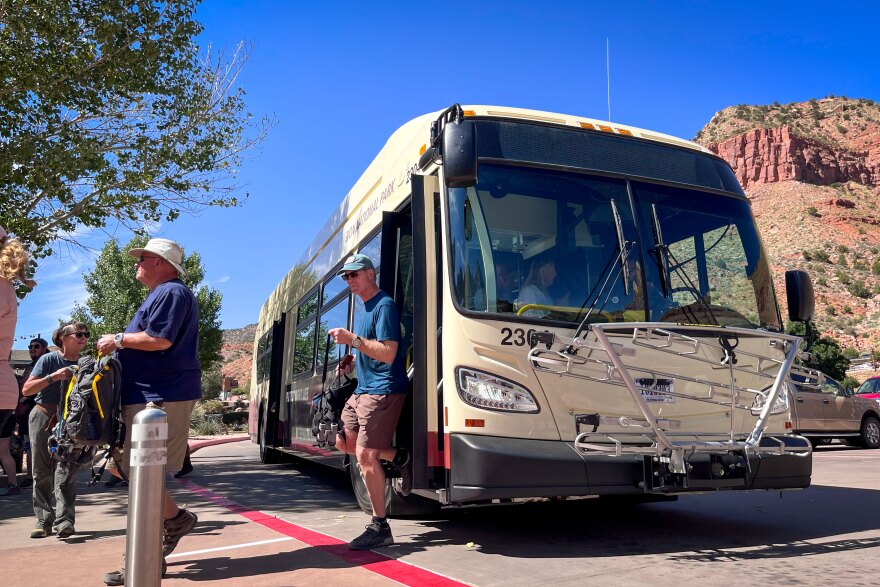At a shuttle stop near Zion National Park’s south entrance, Dean Birmingham sat waiting to board one of the park’s new electric shuttle buses. Visiting from London, he’s in the midst of driving across the West on a massive road trip, so it’s nice to let someone else take the wheel for a change.
“I must have done about 3,000 miles. That’s enough,” Birmingham said.
After a few minutes, the shuttle pulled up with a barely perceptible hum, and he joined the small crowd climbing aboard.
Toward the front, taking in the red rock views from one of the shuttle’s large windows sits Jesse Heaton. He’s visiting from Santa Cruz, California, which is in the midst of transforming its bus system into a zero-emission fleet. Doing the same thing in a spot like this, he said, is a no-brainer.
“It's important, especially in places that are this beautiful, to try to limit emissions as much as possible,” Heaton said. “So it's good to see that transition.”

Zion recently rolled out five electric shuttles like this one to replace aging propane-powered buses on the route that takes visitors from the town of Springdale to the park’s south entrance.
The overhaul will eventually replace all of Zion’s shuttles with 26 fully electric buses — along with 27 charging stations — funded largely by a $33 million U.S. Department of Transportation grant. The park expects the next shipment of shuttles to arrive this winter with plans to begin running them through Zion Canyon next spring.
Zion public affairs specialist Jonathan Shafer said it’s all part of a long-term vision to manage booming visitor numbers while preserving the park’s natural beauty.
“The mission of the park service fundamentally is to provide access and to conserve this special place,” Shafer said, “and we're optimistic that our new fleet is going to be even better at helping to conserve this place than our old fleet.”
Since the park first introduced its free shuttle system in Zion Canyon more than two decades ago, annual visitorship has nearly doubled — from 2.4 million people in 2000 to nearly 4.7 million people in 2022. The park has also grown into an economic juggernaut for southwest Utah, bringing in close to $1 billion for the regional economy last year alone.
With so many people descending on the park, its shuttle system is more than a convenience for travelers — it’s a vital cog in Zion’s operations. The fleet recorded its 90 millionth boarding in August. Without these buses, Shafer said, it would be next to impossible for millions of people to visit this narrow canyon, which he notes only has around 300 parking spaces.
“Our shuttle system is the lifeblood of moving visitors around the canyon. We need it,” Shafer said.
Visitors can’t drive their cars into Zion Canyon for most of the year, and a single bus carries enough passengers to take more than two dozen cars off the road. So the park’s current fleet has been drastically reducing the tailpipe emissions in Zion’s air already. Replacing the propane buses — many of which Shafer noted are at the end of their lifespans — with electric ones that should be able to do an entire daytime shift on one overnight charge takes the park’s mission of conservation a step further.

The fleet upgrade will have tangible benefits for visitors, too, starting with their ears. The electric vehicles run much quieter than the old ones. So hikers on Scout Lookout or Angel’s Landing will get to listen to more natural soundscapes and less engine noise.
“We're going to have more opportunities to hear the wind blowing through the canyon, to hear the Virgin River, which is forming the canyon,” Shafer said. “People are going to be able to get a different experience than what they've had before.”
Another perk of the new buses is air conditioning. That’s something the previous fleet lacked. So when summer temperatures soar above 100 degrees, the rides will offer visitors a place to cool down between hiking stops.
Eventually, Zion’s electric buses could be part of a sprawling regional transit plan surrounding the park.
St. George plans to start a bus line to carry guests between southwest Utah’s largest city and Springdale next year. On the opposite side of the park from Springdale, there’s another effort aimed at transporting more park visitors without tailpipe emissions: EVZion.
The Utah Clean Cities Coalition pilot project is testing how two electric shuttles perform on the park’s east side, which has different challenges than Zion Canyon, including steep inclines, hairpin turns and a 1.1-mile tunnel that was built when Model T-sized vehicles ruled the road.
The EVZion shuttles aren’t carrying passengers into the park, coalition executive director Tammie Bostick said, but the data they’re collecting will provide a model that Zion or any other park could someday use to implement zero-emission transit.
“The plan is to pilot it and demonstrate it and then to scale and replicate it,” she said. “So we can go from two to four to 20 to 30 shuttles and know essentially what we're going to be getting.”
The coalition is also studying what it might take to someday expand transit across southwest Utah to connect Zion with places like Kanab, Cedar City, Bryce National Park and even the Grand Canyon’s north rim. That would not only benefit tourists, Bostick said, but also people living in rural areas and employees commuting to jobs in or around parks.






